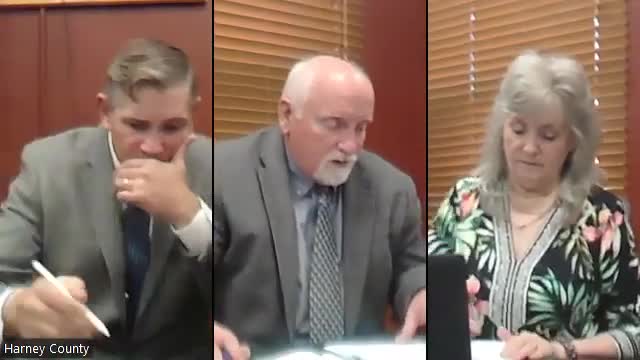Harney County weighs near-term flood mitigation work, seeks reengagement of Klein Schmidt for updated modeling
October 16, 2025 | Harney County, Oregon
This article was created by AI summarizing key points discussed. AI makes mistakes, so for full details and context, please refer to the video of the full meeting. Please report any errors so we can fix them. Report an error »

Harney County commissioners used Oct. 15 court discussion to review options for flood mitigation in the wake of earlier flooding and the Klein Schmidt study that evaluated alternatives for protecting homes and infrastructure.
Commissioners and staff said the county faces a narrow window to implement mitigation work before winter and spring runoff make fieldwork impractical. One option flagged during the meeting was reengaging Klein Schmidt to rerun models with 2025 event data to determine which interventions would reduce flood risk for the greatest number of homes and which could inadvertently increase risk elsewhere.
The court discussed smaller, quicker actions the roadmaster suggested, including installing a series of smaller culverts at one location to improve conveyance while limiting machine-time and permitting scope. Staff said a single larger arch culvert previously identified in study alternatives would not fit the existing roadbed and that extensions would be "tens of thousands of dollars." Roadmaster Eric Uschela and the planning director said smaller culverts or a cluster of culverts may be more practicable in the near term.
Commissioners said they would consult with state officials — including a scheduled meeting between county staff and representatives from the governor's regional solutions office and Business Oregon — to confirm which immediate uses of awarded state mitigation funds would be authorized. County officials said a reengagement estimate for Klein Schmidt's modeling work is approximately $100,000 and that the county could seek loans or reimbursement approaches where the county performs work now and is reimbursed by awarded funds later.
The court also noted the need to involve affected landowners and federal agencies (Army Corps, BLM, U.S. Forest Service) sooner rather than later to understand permitting and downstream impacts, such as channel dredging or debris removal that could affect flows elsewhere.
No formal action was taken at the Oct. 15 meeting; commissioners instructed staff to pursue conversations with state contacts about flexibility in fund use and to seek an updated model from Klein Schmidt so the county can prioritize mitigation that reduces overall risk.
Votes at a glance: No formal vote; staff directed to pursue updated modeling and state guidance.
Commissioners and staff said the county faces a narrow window to implement mitigation work before winter and spring runoff make fieldwork impractical. One option flagged during the meeting was reengaging Klein Schmidt to rerun models with 2025 event data to determine which interventions would reduce flood risk for the greatest number of homes and which could inadvertently increase risk elsewhere.
The court discussed smaller, quicker actions the roadmaster suggested, including installing a series of smaller culverts at one location to improve conveyance while limiting machine-time and permitting scope. Staff said a single larger arch culvert previously identified in study alternatives would not fit the existing roadbed and that extensions would be "tens of thousands of dollars." Roadmaster Eric Uschela and the planning director said smaller culverts or a cluster of culverts may be more practicable in the near term.
Commissioners said they would consult with state officials — including a scheduled meeting between county staff and representatives from the governor's regional solutions office and Business Oregon — to confirm which immediate uses of awarded state mitigation funds would be authorized. County officials said a reengagement estimate for Klein Schmidt's modeling work is approximately $100,000 and that the county could seek loans or reimbursement approaches where the county performs work now and is reimbursed by awarded funds later.
The court also noted the need to involve affected landowners and federal agencies (Army Corps, BLM, U.S. Forest Service) sooner rather than later to understand permitting and downstream impacts, such as channel dredging or debris removal that could affect flows elsewhere.
No formal action was taken at the Oct. 15 meeting; commissioners instructed staff to pursue conversations with state contacts about flexibility in fund use and to seek an updated model from Klein Schmidt so the county can prioritize mitigation that reduces overall risk.
Votes at a glance: No formal vote; staff directed to pursue updated modeling and state guidance.
View full meeting
This article is based on a recent meeting—watch the full video and explore the complete transcript for deeper insights into the discussion.
View full meeting
